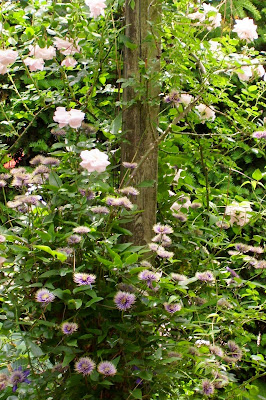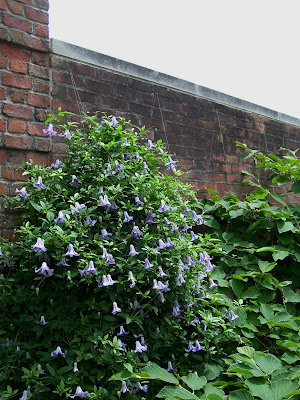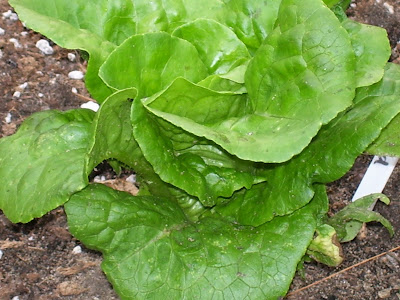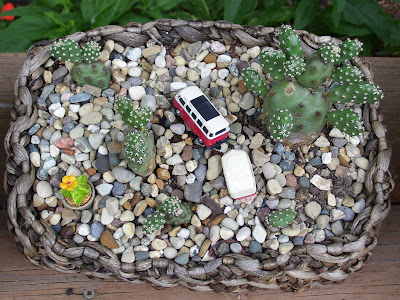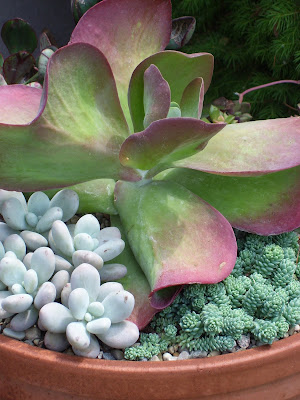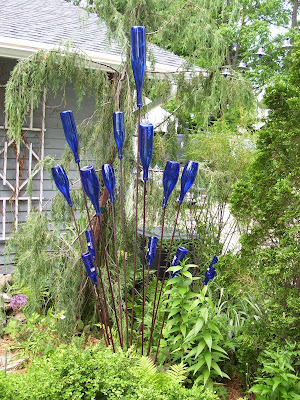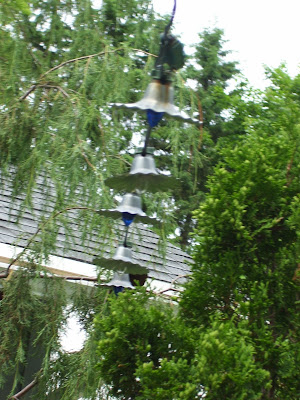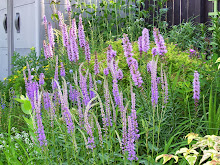
Community gardening plots by Goodwill in Outagamie County

A raised bed stringed off in the "square-foot garden" style
One of the gardens featured on the Outagamie Master Gardeners Garden Walk was a garden at the
Goodwill Industries Menasha . The purpose of their garden as stated on the linked site is :
"Community Garden Partnership provides opportunities for diverse groups
to share their experiences and knowledge with other gardeners
at a variety of community locations while also promoting such
things as self-sufficiency, environmental stewardship, creation
of healthy civic space, and donations to food banks."
When I visited the Community Garden the docent from the Master Gardeners organization quoted that phrase for me pretty much verbatim. He intended to be my guide through the garden. I really didn't need a guide to help me keep my feet off the tomatillos and didn't want to get into my own back story, so I told him my son and I would be fine on our own.
It was probably rude. My son told me I was and probably hurt his feelings. He probably had had very few visitors all day and wanted to do his part to contribute. We did sit down at the picnic table when we were done and chat up him and his fellow docent, because then, I did have some questions.
The garden is roped off into 10' x 10' squares. In the small space the entire plot envelopes, the soil type changes radically on a sharp diagonal line from a sandy loam to clay. It is in the shadow of a major highway and lots of developed and black-topped areas. I would assume some topsoil may have been hauled in for lawn at some point accounting for this major demarcation.
To further cut down on growing space there are tiny foot paths around the raised beds in any gardener's plot. It appears one Gardener took his entire plot and planted 10' rows of sweet potatoes. Then, in an act of gardening outside the lines, planted hills of corn just outside his stringed partition.
The plot with the biggest tomatoes, and best looking everything else was using commercial synthetic fertilizers and had recently dusted his cucumbers (or more likely zucchini) with Sevin (which is not an organic pesticide, and while it is decidedly a chemical that can get the job done, is not a favorite of mine).
There were no cabbage, no greens (other than what appeared to be a self-seeded Asian mustard from a previous year's community garden), no potatoes, no chard, no beets, no other Asian veggies, no peas, no carrots, no radishes, and no herbs.
There was corn, planted outside the lines and corn planted in the square-foot garden.
There were tomatoes, although they either looked pretty rough and so tiny that with our weather time for fruiting will be doubtful; or looked like ones bought potted and ready to bloom and planted last week.
There were beans. There was one gardener who erected hooped wire fencing over his beds for some sort of vertical gardening.
There were lots of weeds and little well-worked soil. There were few labels other than "yellow beans" or "tomato".
In other words, the gardens provided little information and looked a bit rough.
In addition to providing food for gardeners and food pantries, the gardens are supposed to be a way to share knowledge from newbies from experienced gardeners and tips on different methods from peer to peer.
I didn't see a lot of anything I would want to try.
The raised beds weren't really "raised". More, they were just sort of "boxed". The purpose of a raised bed is to provide a fluffy, improved soil bed and/or bring up the level of a bed to allow less enabled gardeners better access and ergonomic position while gardening. It seems the beds there missed all that.
I also had the obvious misconception that the gardens would be touting environmentally sustainable practices. There was no composting being done or being used. There was no community compost pile.
When I spoke to the docents, they told me that when the community garden idea was put together the organizers felt they could not put any limitations on organic versus synthetic. I totally get that, but I was hoping minimally for some sustainable methods.
Another aspect that bothered me, in regards to the teaching aspect was lack of identification of varietal types. Personally, I feel this is the biggest challenge to gardeners. In zone 4, I feel we are often just lumped in with the greater Midwest which is predominantly zone 5-7 and sent transplants that do well in the region versus our local area.
When I expressed my concern over the loss of varietal information for plants that will reliably do well here, the elder docent (who was a Master Gardener) replied, "Generally, regardless how well any particular vegetable does a gardener will get enough produce overall to make the garden worthwhile."
This response floored me. If early settlers to Wisconsin in any area had zero germination for their 'Jubilee' sweetcorn, as I did this year, they couldn't run out to the seed store and reliable buy more seed the next year. If their potato crop developed late blight, there was starvation.
This is a little like the "Let them eat cake attitude" which has gotten politicians the world over in hot water or worse. It is a bit like the attitude prevalent after Katrina. "They" were warned, why didn't "they" leave. It was the poorer people with no big SUVs, credit cards, and more importantly cash nor "place to leave to" that stayed behind in New Orleans. Policy makers not of that socio-economic group didn't understand why "they" would stay.
Fortunately, I can run out the next spring and buy some other sweet corn seed, but if I wanted to eat local and had planted only 'Jubilee', I wouldn't be eating sweetcorn this year. By the way, although it is not a crop
yet, I did get great germination from sweetcorn 'Early Sunglow, even with our cold, wet spring.
I will go back and check out this community garden sometime late July, and other community gardens in the Fox Valley because gardening is a learning and growing experience.
